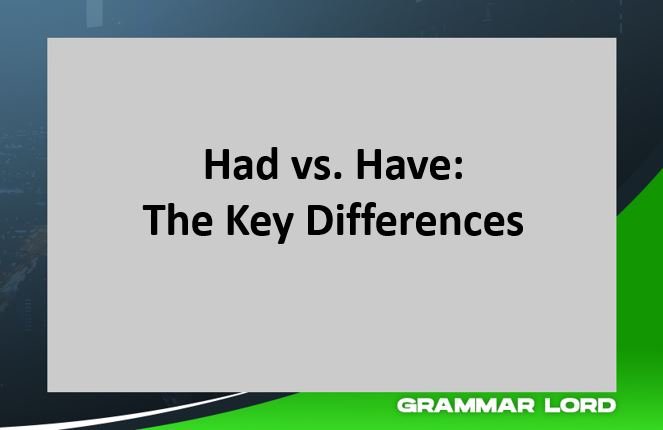Are you confused about when to use “had” and “have”? Many English learners struggle with these two words. However, In this guide, we’ll help you understand the key differences between “had” and “have” so you can use them correctly in your writing.
READ ALSO: Below Vs. Bellow: What’s The Difference
Contents
What Is The Difference Between “Had” And “Have”?
| Feature | Had | Have |
|---|---|---|
| Tense | Past Perfect | Present Perfect, Present Simple |
| Function | Expresses an action completed before another past action | Expresses actions completed before now, possession, or states |
| Example | I had finished dinner before they arrived. | I have lived here for 5 years. |
Had
Past Perfect Tense:
“Had” is primarily used to form the past perfect tense, which is used to describe actions that were completed before another action in the past.
Example: I had eaten dinner before they arrived.
Conditional Sentences:
“Had” can also be used in conditional sentences, often in the “if” clause.
Example: If I had known you were coming, I would have baked a cake.
Have
Present Perfect Tense:
One common use of “have” is in the present perfect tense. This tense describes actions that happened in the past but have a connection to the present.
Example: I have lived in this city for five years.
Present Simple Tense:
“Have” is also a main verb, often used to express possession or states.
Example: I have a car.
Auxiliary Verb:
It can be used as an auxiliary verb for other verbs.
Example: I have been waiting for you.
In essence, “had” is typically used to talk about things that happened before other past events, while “have” is more versatile, used for present perfect actions, possession, and as an auxiliary verb.
READ ALSO: Accompanied By Vs Accompanied With: The Key Differences
When To Use “Had”
“Had” signifies an action completed before another past action. However, here are some cases where you can use “had:”
Actions Completed Before Another Past Action:
When describing a sequence of events in the past, “had” is used to indicate the action that occurred first.
Example: I had finished my homework before he called. In this example, “had finished” tells an action completed prior to “he called.”
Past Perfect Continuous Tense:
To express an action that started and continued before another past action, use “had been” + verb-ing.
Example: She had been studying for hours before the exam started.
Conditional Sentences:
In Type 3 conditional sentences, “had” is used in the “if” clause to express an unreal or impossible past condition.
Example: If I had known you were coming, I would have prepared dinner.
Reported Speech:
When reporting something someone said in the past, you might use “had” to shift the tense.
Example: She said she had seen the movie before.
When To Use “Have”
Unlike “had,” which is primarily tied to the past perfect tense, “have” is more adaptable. It can function as a main verb, and an auxiliary verb, and is essential in forming the present perfect tense.
Have As A Main Verb
As a main verb, “have” typically expresses possession, ownership, or relationships.
Possession:
This is the most common usage. It indicates that something belongs to someone.
Example: I have a car.
Relationships:
“Have” can also express relationships or connections.
Example: We have friends in common.
Have As An Auxiliary Verb
In this role, “have” assists other verbs to form different tenses, primarily the present perfect and present perfect continuous.
Present Perfect Tense:
Combines with the past participle to indicate actions completed in the past with a present relevance.
Example: She has lived in New York for five years.
Present Perfect Continuous Tense:
Used to emphasize the duration of an ongoing action that started in the past.
Example: They have been studying for the exam all day.
READ ALSO: Past Tense Of Show: Showed Vs Shown
FAQs About Had vs. Have: The Key Differences
What Is The Difference Between “Had” And “Have” In The Present Perfect Tense?
“Had” is used in the past perfect tense, while “have” is used in the present perfect tense. The past perfect refers to an action completed before another past action, whereas the present perfect refers to an action completed in the past with a connection to the present.
Can “Had” Be Used In The Present Tense?
No, “had” is specifically used for the past perfect tense. It cannot be used in the present tense.
When Should I Use “Would Have”?
“Would have” is used in conditional sentences to express an unreal or impossible past condition.
Example: If I had known you were coming, I would have prepared dinner.
What Is The Difference Between “Have To” And “Had To”?
“Have to” expresses necessity in the present or future, while “had to” expresses necessity in the past.
Example: I have to finish this report today.
Example: I had to study hard for the exam.
Can “Had” Be Used As A Main Verb?
No, “had” is primarily an auxiliary verb used to form the past perfect tense. It cannot be used as a main verb.

